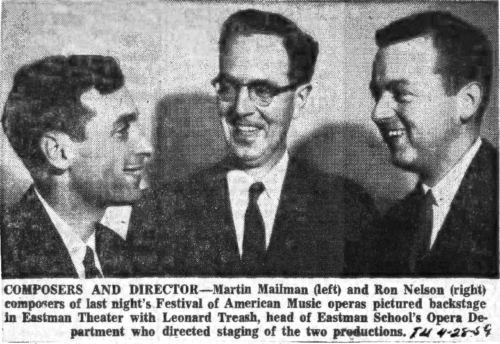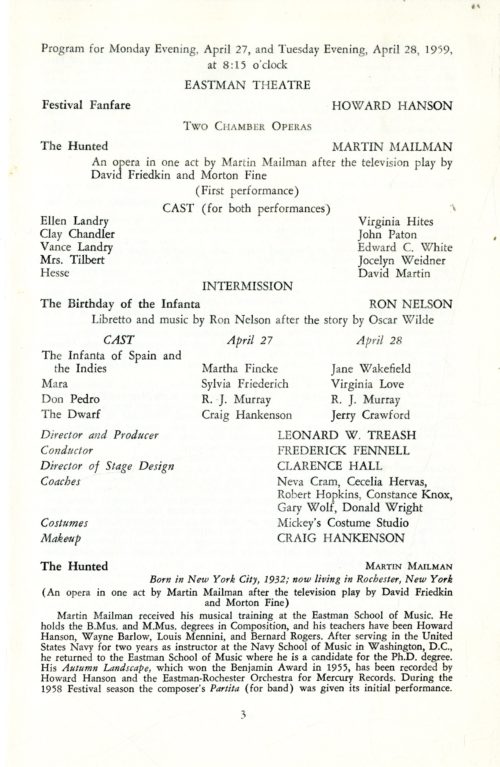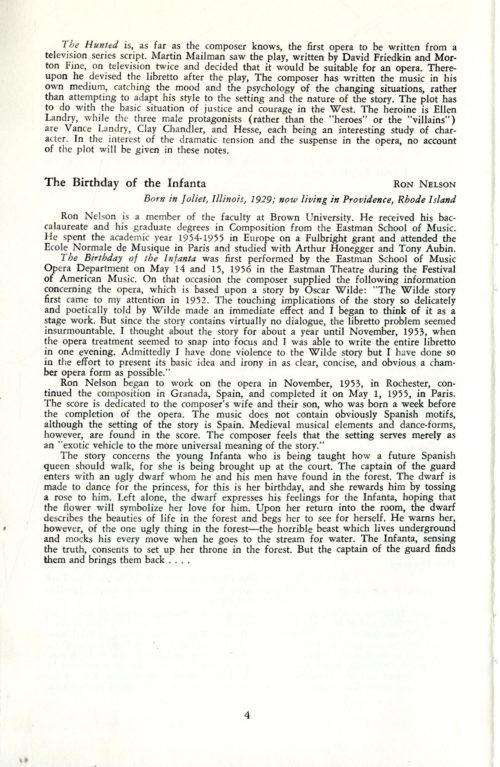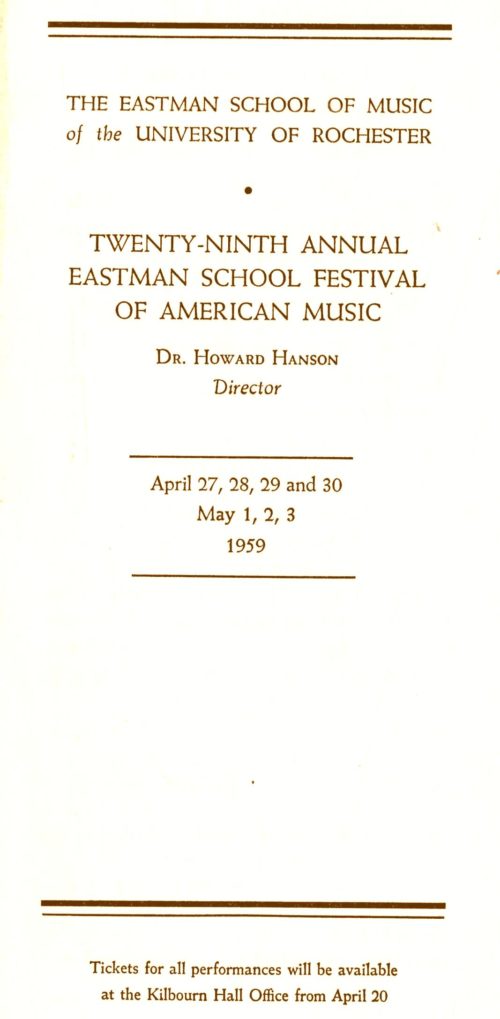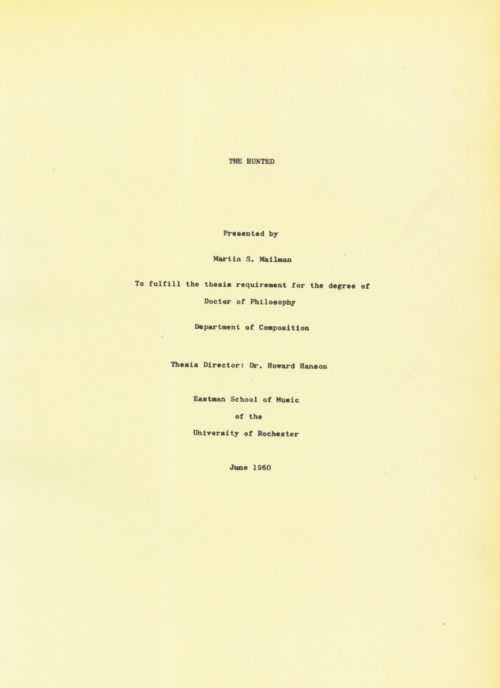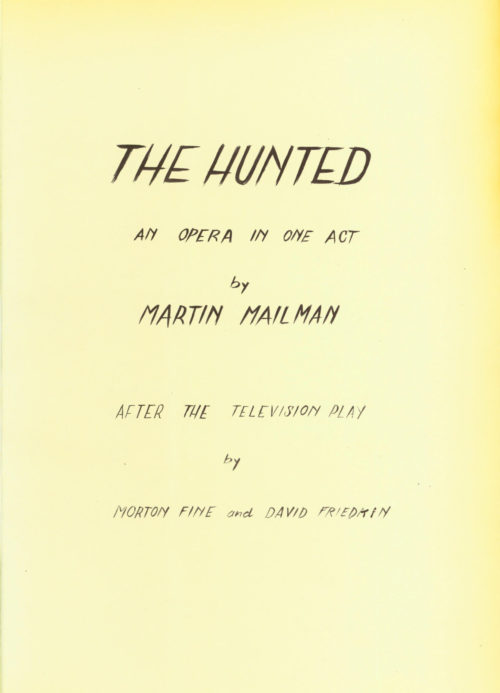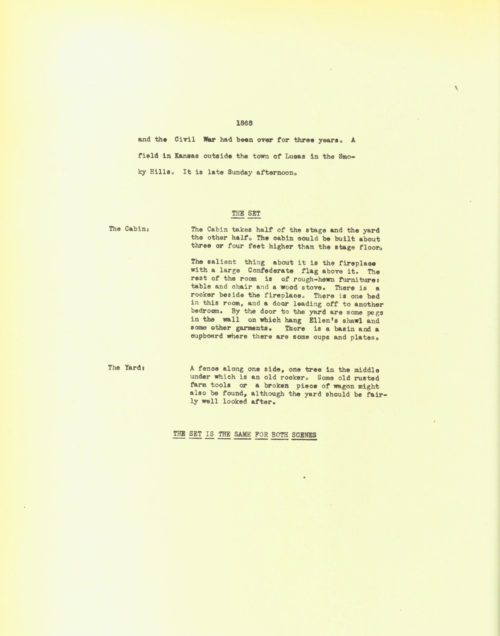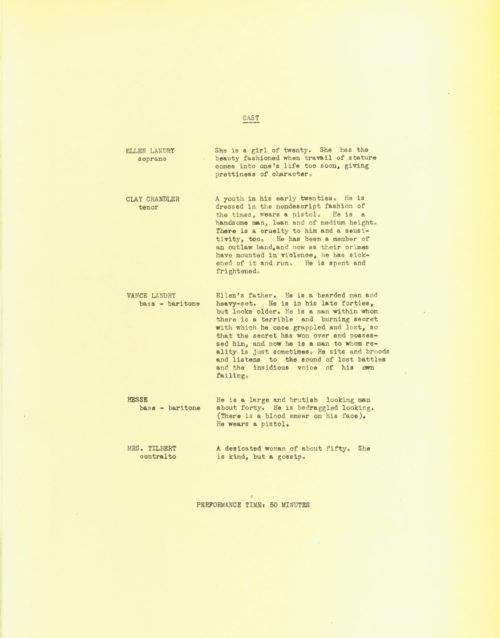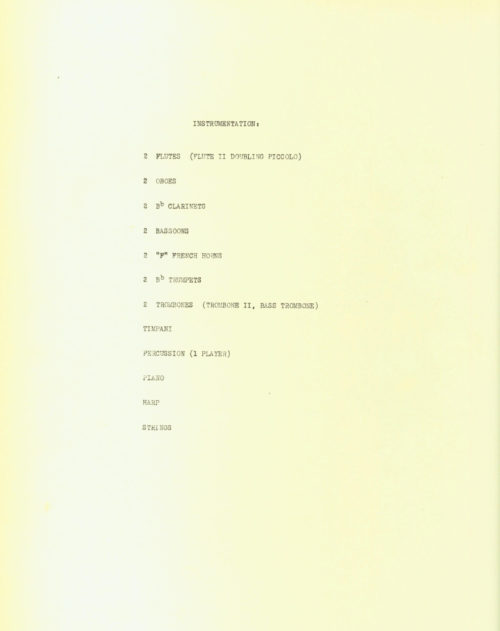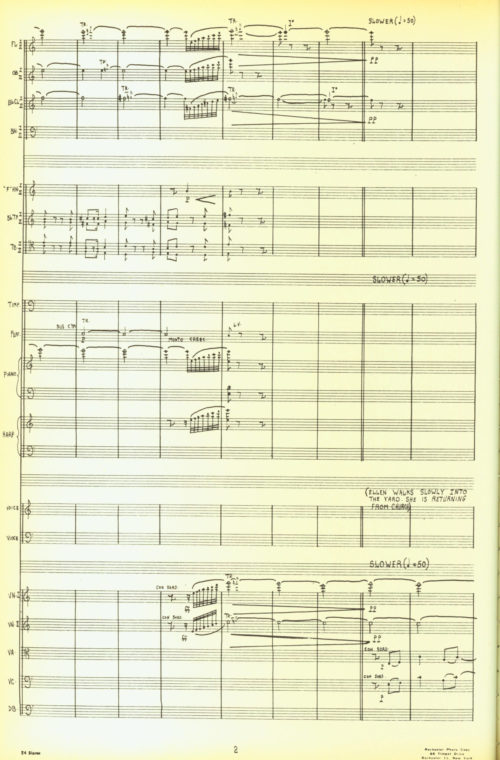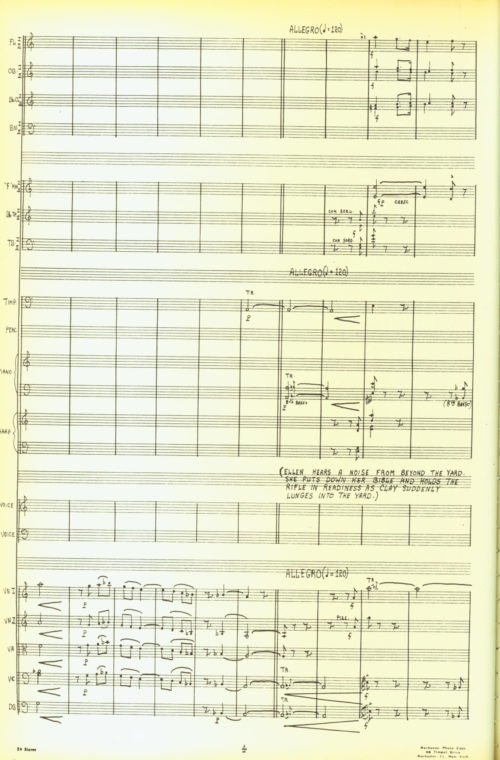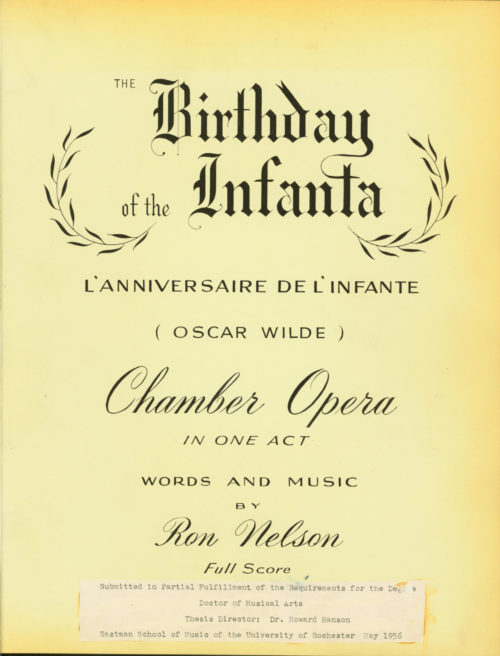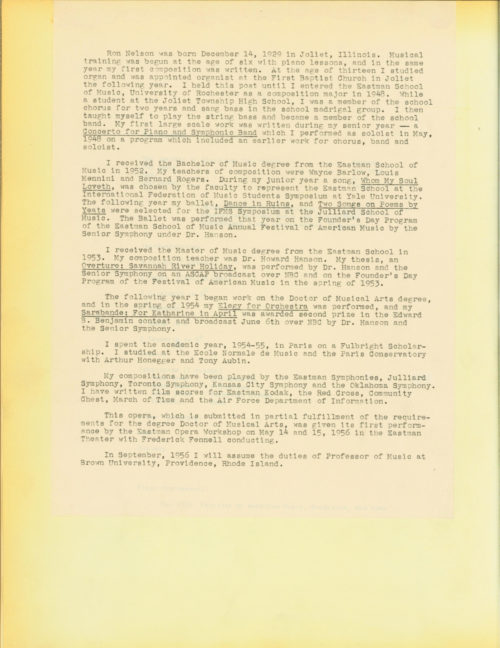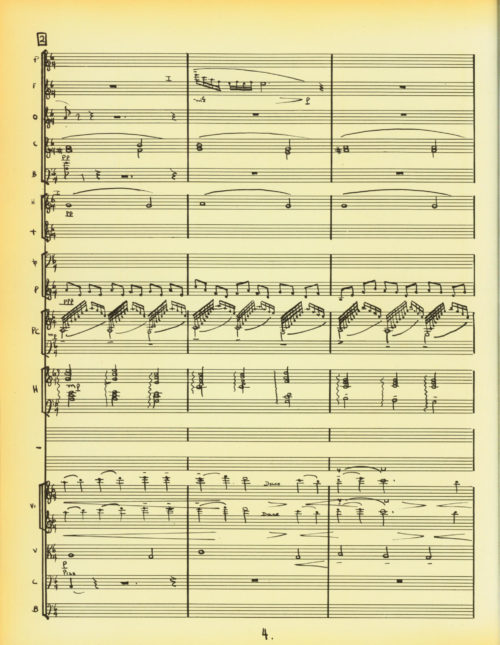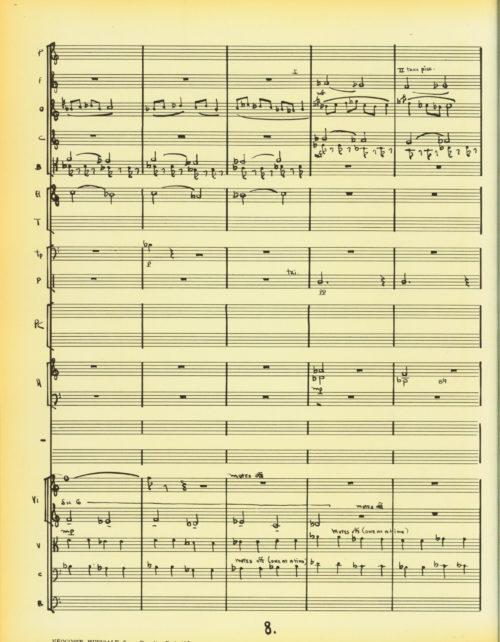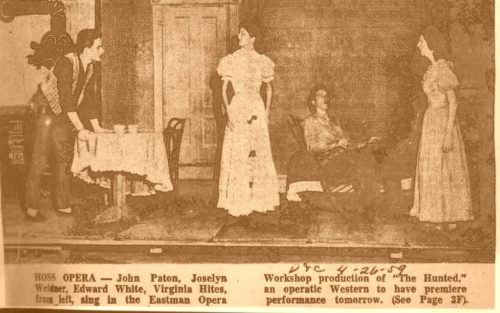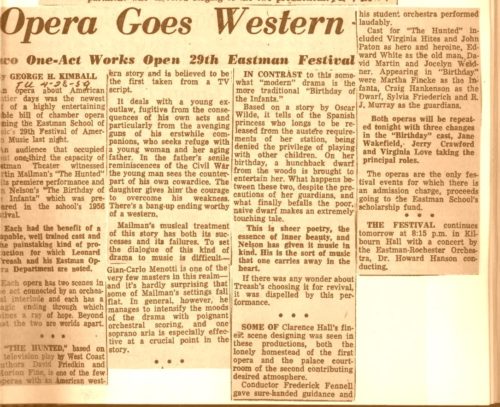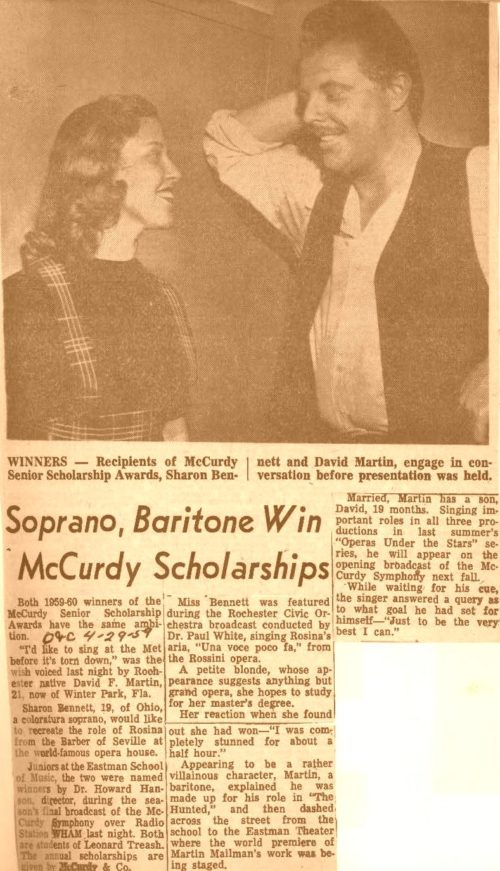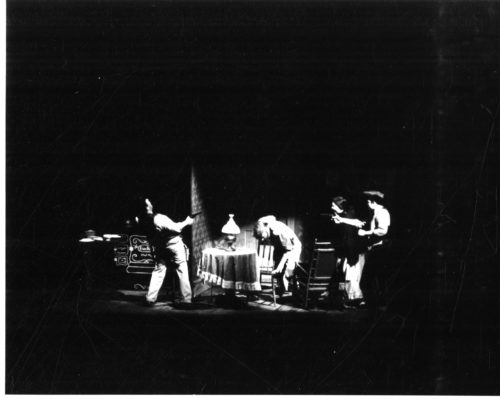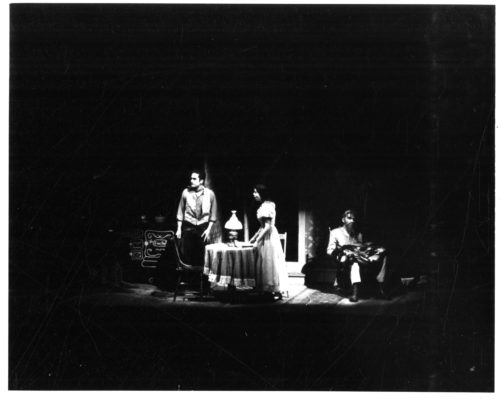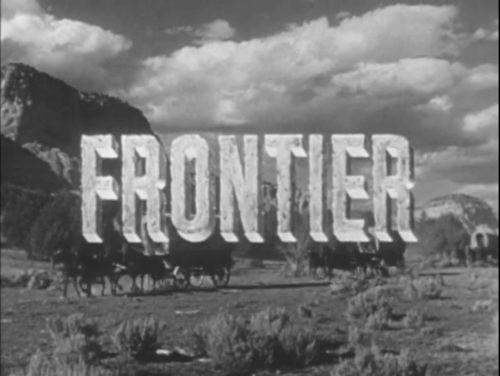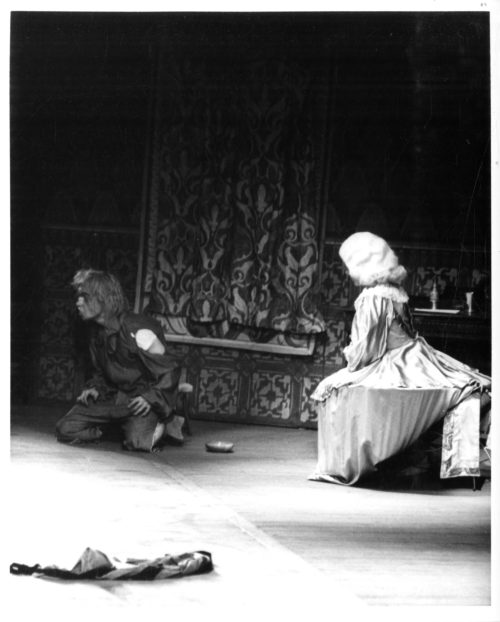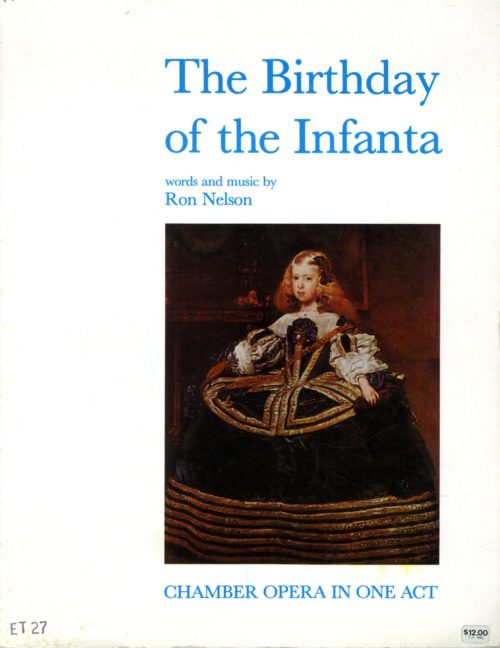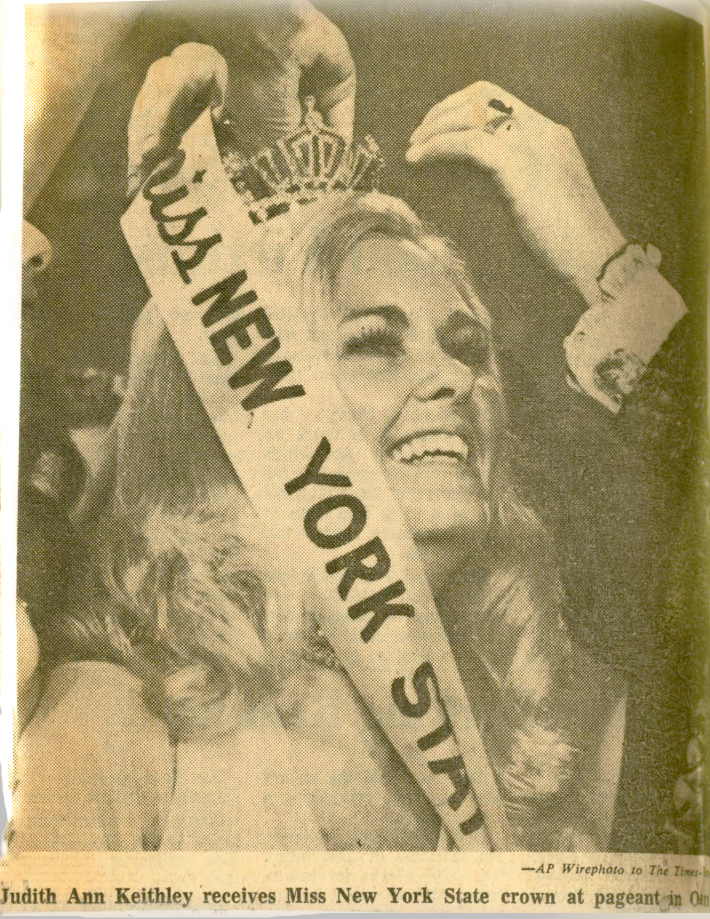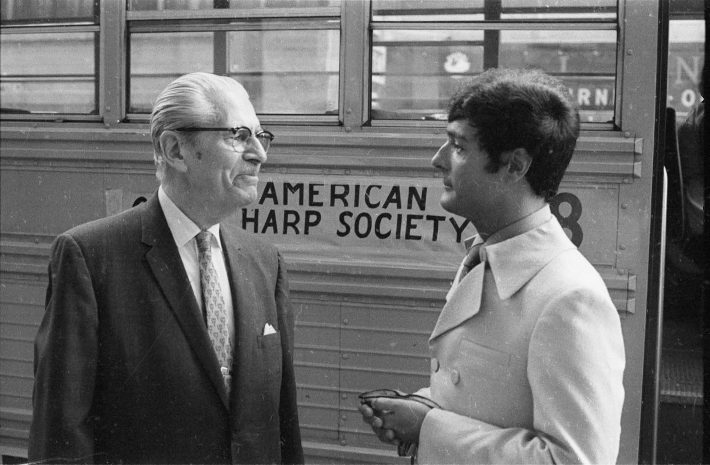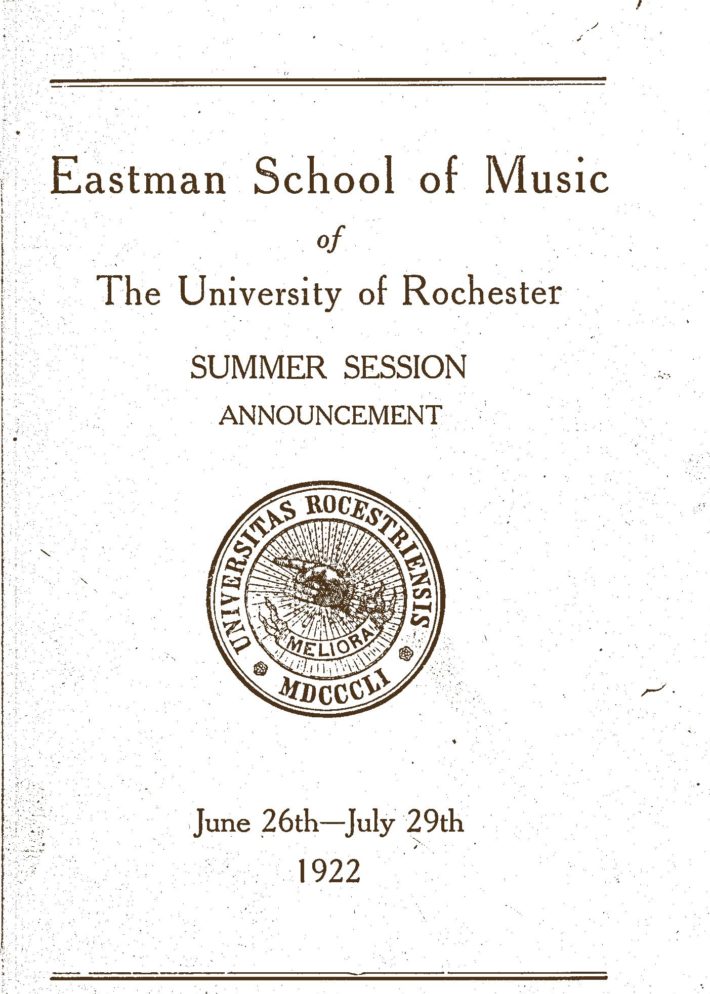1959: An eclectic operatic double-bill at the Festival of American Music
Two pistols drawn—and a man staggering backwards, mortally wounded by gunfire—these frontier elements were in evidence sixty-four years ago this week on April 27th and 28th, 1959, when the Eastman School’s Opera Workshop staged The Hunted, a chamber opera in one act by composition postgraduate Martin Mailman. With a libretto based on the script of an episode of Frontier, a popular television series of the day, The Hunted was on a double bill of chamber operas that opened Eastman’s 29th annual Festival of American Music. Paired with the premiere performances of The Hunted was a second production of Ron Nelson’s The Birthday of the Infanta, similarly an opera by an Eastman composition postgraduate, which had been premiered at the 1956 Festival of American Music. The operatic double-bill was directed by Leonard Treash; the orchestral forces were conducted by Frederick Fennell.
► The entire programming for the 1959 Festival of American Music at the Eastman School.
The Eastman School’s annual Festivals of American Music dated back to 1931, when Howard Hanson organized a four-day Festival of performances to mark the Eastman School’s ten-year anniversary. The following year, a similar Festival was promoted for the first time as the Festival of American Music, and thereafter such festivals took place annually until 1971, providing a forum for performances of new works by American composers.[1] The Festivals were widely publicized, including in the national music journals and in the nation’s larger newspapers. For purposes of inclusion and eligibility, Hanson interpreted “American” broadly to apply to any composer who was resident in (including composers newly arrived from elsewhere) any of the Americas, in either the Northern or Southern Hemisphere. The Festivals quickly grew in duration and scope, generally following a fixed model: one evening for chamber music, one evening for ballet, one evening for symphonic music, one evening for symphonic band or wind ensemble, one evening for opera, and always a so-called Founder’s Day concert in honor of George Eastman. The opera evening frequently featured a double-bill or evening triple-bill of one-act operas. It is in those operatic productions during the annual Festivals that one sees most clearly that Eastman Opera, then as now, has always championed new work. Granted, under the auspices of Hanson’s Festivals the content was always America, but one underlying take-away remains: taking into consideration the programming at the annual Festivals, Eastman Opera was as much about the new as about the traditional and the canonic, under two successive artistic directors, Nicholas Konraty (served 1929-47) and Leonard Treash (served 1947-76). To name just a few examples: in 1954, Mr. Treash directed George Antheil’s Volpone, barely more than a year after that work’s premiere; in 1952 he directed Menotti’s The Consul (premiered just two years earlier); in 1953 he directed Weill’s Street Scene (premiered just six years earlier); he also directed the premiere productions of several works composed by Eastman School-affiliated composers, whether faculty members or postgraduate composition students, including (future Pulitzer Prize winner) Dominick Argento and the two composers with whom we’re concerned in the 1959 Festival.
► The title page, front matter, and opening pages of music of the manuscript full score of Martin Mailman’s chamber opera The Hunted.
► The title page, front matter, and opening pages of music of the manuscript full score of Ron Nelson’s chamber opera The Birthday of the Infanta.
Both Martin Mailman (1932-2000) and Ron Nelson (b. 1929) were high-achievers in Howard Hanson’s composition class. One had won the Eastman School’s prestigious Edward B. Benjamin Award for composition, and the other had been a second-place runner-up for the same award. Hanson’s recognition of both men via programming at the Festival of American Music was a singular accolade reserved for the very few among his enrolled postgraduates. Mr. Nelson had received the D.M.A. in 1957, by which time he had already assumed a professional appointment at Brown University in the fall of 1956 (he would retire in 1992 with professor emeritus status). Mr. Mailman would receive the Ph.D. degree in 1960 and would be appointed to the faculty of the University of North Texas (Denton) in 1966, serving until his death in 2000 (upon which he was posthumously recognized with emeritus status). Each man’s chamber opera at the 1959 Festival represented his doctoral thesis composition, completed in fulfillment of degree requirements.
The content in these two chamber operas was definitely eclectic. Mr. Mailman had based on his opera The Hunted on one episode in the popular television series Frontier (1955-56), a program which attempted to present an unvarnished, unglamorized view of life in the American West drawing on primary sources.[2] The libretto was based on the script of the episode “The Hunted” written by Morton S. Fine (1916-1991) and David Friedkin (1912-1976), two successful and well-known screenwriters of the day. The plot involves the intersection of the fates of two men, each haunted by deeds in his past, and is situated in a particular community in Kansas in 1868, with the American Civil War still fresh in the collective memory. At the opera’s climax, weapons are drawn and two men fall dead. The Rochester press drew particular attention to the opera’s Western subject matter, going so far as to characterize the work as a “hoss opera” (several press items are displayed here). A dramatic element specified in the libretto that apparently was not realized in the Eastman production was the symbol of a large Confederate flag hanging on the interior wall of the hut where the action takes place; further, the flag was to be draped over the corpse of one of the dead men at the end of the opera. However, the symbol of the Confederate flag doesn’t happen to appear in any of the extant photographs.
► Various moments in Martin Mailman’s chamber opera The Hunted, Eastman School of Music, 1959.
Photos by Louis Ouzer with exception of image 2, which lacks an attribution.
Ron Nelson’s The Birthday of the Infanta had been premiered at the Eastman School’s 1956 Festival of American Music, and was given a repeat staging in 1959. The libretto was based, with some artistic license taken, on the short story of the same title by Oscar Wilde (1854-1900). First published in 1889, the story is the poignant tale of a dwarf who is brought to dance for the Spanish Infanta on her birthday; believing that she is in love with him after she tosses him a white rose, he steals into the palace in an attempt to find her, only to see his reflection in a mirror and realize his true physical appearance before dying of a broken heart. The closing words belong to the child Infanta. “And the Infanta frowned, and her dainty rose-leaf lips curled in pretty disdain. ‘For the future let those who come to play with me have no hearts,’ she cried, and she ran out into the garden.” There are numerous interpretations of the story, including finding in it the myth inherent in many different cultures of the fall from grace (think Adam and Eve, among others). There have been numerous adaptions and settings of the story, including an opera (1919-21) by Alexander von Zemlinsky (1871-1942), a ballet (1917-18) by John Alden Carpenter (1876-1951), a ballet (1942; published 1947) by Mario Castelnuovo-Tedesco (1895-1968), and an opera (1976-77) by one of Mr. Nelson’s Eastman postgraduate classmates, Malcolm Seagrave (1928-2001). The vocal score of Mr. Nelson’s opera was published by the Eastman School, with sole selling rights held by Carl Fischer, LLC; fittingly, the front cover bears a detail from the painting The Infanta Margarita Teresa in a blue dress (1659) by Diego Velázquez (displayed here).
The cast of The Hunted numbered five players in all:
Virginia Hites (later Mrs. Virginia Romano) (role of Ellen Landry), BM ’59
John Paton (role of Clay Chandler), BM ’59, PC ’60
Edward C. White (role of Vance Landry), BM ’59, PC ’60, MM ’61
Jocelyn Weidner (role of Mrs. Tilbert), BM ‘59
David Martin (role of Hesse), BM ’60, MM ’61
Two of these graduates went on to academic careers: Mr. Paton at the University of Southern California; Mr. White at the University of Alabama-Tuscaloosa.
The production of The Birthday of the Infanta was double-cast between the two evenings, with one performer repeating his role on the second evening:
Martha Fincke (later Mrs. Martha Boone Bacon) (role of The Infanta), BM ’59
Jane Wakefield (later Mrs. Jane Carmichael) (role of The Infanta), BM ‘59
Sylvia Friederich (role of Mara), BM & PC ’59, MM ’71
Virginia Love (later Mrs. Virginia Offermann) (role of Mara), BM ’58, PC ’59
R. J. Murray (role of Don Pedro; repeated the role on the second night), MAS ’58
E. Craig Hankenson, Jr. (The Dwarf), BM ’57, MM ’59
H. Gerald (Jerry) Crawford (The Dwarf), BM ’59, PC ’60, MM ’72
Two of these performers became opera singers: Ms. Friederich, based in New York City, and Ms. Love, based in Germany. Mr. Murray became general director of the Shreveport Opera (Shreveport, Louisiana); Mr. Hankenson became general manager of the Saratoga Performing Arts Center (Saratoga, New York); and Mr. Crawford was appointed to the faculty of Oberlin Conservatory.
► Various moments in Ron Nelson’s chamber opera The Birthday of the Infanta, Eastman School of Music, 1959.
Photos by Louis Ouzer.
As noted, the vocal score of The Birthday of the Infanta was published by the Eastman School of Music, with sole selling rights assigned to Carl Fischer, LLC; the opera’s performing materials are available on rental from Carl Fischer’s rental library (which is operated out of the Theodore Presser rental library, the two companies being sister companies since 2004). At one time, the performing materials for The Hunted were available for hire from Mills Music/Belwin-Mills/Alfred Music Publishing, but the title no longer shows up in the Alfred Music Publishing catalogue. The Hunted was staged once at the University of North Texas during Dr. Mailman’s faculty service there. While both Dr. Mailman and Dr. Nelson went on to compose prolifically and to earn numerous professional recognitions, neither would ever again invest much creative energy in the operatic medium. Nevertheless, the confidence of their mentor Howard Hanson had won each of them a spot in the 1959 Festival of American Music, with the school’s stellar performance resources at their disposal. Standard procedure under Howard Hanson would have directed that the performances be recorded, but strangely, neither opera shows up in the Eastman Audio Archive catalogue. (The 1956 production of Dr. Nelson’s opera was, in fact, recorded.) Nevertheless, these productions are described in the photographic and press sources presented here, and they contribute to the rich performance history that Eastman Opera embodies. And in the meantime, the Eastman Opera centennial (2023-24) approaches! Stay tuned for more.
[1] Andrea Kalyn’s doctoral dissertation (2001) addresses the Festivals comprehensively, from their origins to their eventual conclusion. Constructing a nation’s music : Howard Hanson’s American Composer’s Concerts and Festivals of American Music, 1925-71, by Andrea Sherlock Kalyn. Thesis (Ph.D.), University of Rochester, 2001.
[2] The spoken narration in the opening theme and credits for the program ran thus: “The material for Frontier is gathered from material diaries, letters, and official records. The stories are true—sometimes heroic, sometimes gentle. All are part of our American heritage. Tonight’s story is such a story.” URL: https://youtu.be/hAAgviepLW4, accessed on April 17, 2023.


